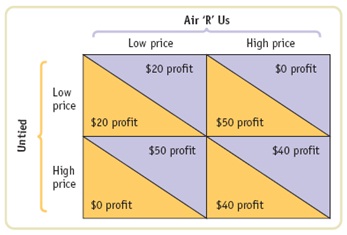Problem 1: Untied and Air ’R’ Us are the only two airlines operating flights between Collegeville and Bigtown. That is, they operate in a duopoly. Each airline can charge either a high price or a low price for a ticket. The accompanying matrix shows their payoffs, in profits per seat (in dollars), for any choice that the two airlines can make.

a. Suppose the two airlines play a one-shot game—that is, they interact only once and never again. What will be the Nash (noncooperative) equilibrium in this one-shot game?
b. Now suppose the two airlines play this game twice – therefore two payoffs to add up each time. And suppose each airline can play one of two strategies: it can play either “always charge the low price” or “tit for tat”— that is, it starts off charging the high price in the first period, and then in the second period it does whatever the other airline did in the previous period. Write down the payoffs to Untied from the following four possibilities:
i. Untied plays “always charge the low price” when Air ’R’ Us also plays “always charge the low price.”
ii. Untied plays “always charge the low price” when Air ’R’ Us plays “tit for tat.”
iii. Untied plays “tit for tat” when Air ’R’ Us plays “always charge the low price.”
iv. Untied plays “tit for tat” when Air ’R’ Us also plays “tit for tat.”
Problem 2: Over the last 30 years the Organization of Petroleum Exporting Countries (OPEC) has had varied success in forming and maintaining its cartel agreements.
Explain how the following factors may contribute to the difficulty of forming and/or maintaining its price and output agreements.
a. New oil fields are discovered and increased drilling is undertaken in the Gulf of Mexico and the North Sea by nonmembers of OPEC.
b. Crude oil is a product that is differentiated by sulfur content: it costs less to refine low-sulfur crude oil into gasoline. Different OPEC countries possess oil reserves of different sulfur content.
c. Cars powered by hydrogen are developed.
Problem 3: “In the long run, there is no difference between monopolistic competition and perfect competition.” True, false, or ambiguous?
Discuss this statement with respect to the following:
a. The price charged to consumers
b. The average total cost of production
c. The efficiency of the market outcome
d. The typical firm’s profit in the long run
Problem 4: In each of the following cases, explain how the advertisement functions as a signal to a potential buyer. Explain what information the buyer lacks that is being supplied by the advertisement and how the information supplied by the advertisement is likely to affect the buyer’s willingness to buy the good (3-part answers for each situation)
a. “Looking for work. Excellent references from previous employers available”.
b. “Electronic equipment for sale. All merchandise carries a one-year, no-questions-asked warranty”.
c. “Car for sale by original owner. All repair and maintenance records available”.